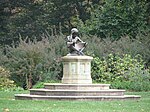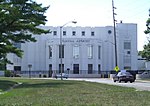Golden Hill Historic District (Indianapolis, Indiana)

Golden Hill is an affluent and historic neighborhood overlooking the White River on the west side of Indianapolis's Center Township, in Marion County, Indiana. The district is bounded on the east by Clifton Street, which is west of Martin Luther King Jr. Boulevard (formerly Northwestern Avenue); on the west by the White River and the Central Canal; on the south by Thirty-sixth Street; and on the north by Woodstock Country Club, immediately south of Thirty-eighth Street. Golden Hill is noted for its collection of homes designed by several of the city's prominent architects. The estate homes reflect several styles of period revival architecture. The district is known as for its community planning and remains an exclusive enclave for the city's prominent families. Golden Hill was added to the National Register of Historic Places in 1991. Originally platted by 1872, the area remained undeveloped until David McLean Parry, a wealthy Indianapolis industrialist, acquired a 100 acres (40 hectares) tract on a ridge overlooking the White River between 1900 and 1907. The neighborhood takes its name from Parry's Golden Hill estate home. Scottish landscape architect George MacDougall designed its grounds. Further development began after Parry's death in 1915, when Parry's heirs hired MacDougall to plan an elegant residential subdivision. Platted as Golden Hill Estates, it was among the city's elite neighborhoods by the 1920s. Fifty-four grand homes, several of them designed by Indianapolis's leading architects, were built along Golden Hill's winding, tree-lined streets. All but eleven of them were built between 1915 and 1940, the historic district's period of significance. The neighborhood's oldest home dates to 1895. One of Golden Hill's unusual features was an Alaskan totem pole that once stood near on the Parry estate. Totem Lane is named in reference to the local landmark, which was one of fifteen totem poles that Alaska's district governor, John Green Brady, collected from villages in southeastern Alaska in 1903. They were displayed at the Louisiana Purchase Exposition in Saint Louis in 1904. (The one that ended up at Golden Hill was placed outside the Esquimau Village.) A replica of the Golden Hill totem pole is installed at The Eiteljorg Museum of American Indians and Western Art in Indianapolis.
Excerpt from the Wikipedia article Golden Hill Historic District (Indianapolis, Indiana) (License: CC BY-SA 3.0, Authors, Images).Golden Hill Historic District (Indianapolis, Indiana)
Totem Lane, Indianapolis
Geographical coordinates (GPS) Address Nearby Places Show on map
Geographical coordinates (GPS)
| Latitude | Longitude |
|---|---|
| N 39.819166666667 ° | E -86.185 ° |
Address
Totem Lane 3644
46208 Indianapolis
Indiana, United States
Open on Google Maps






